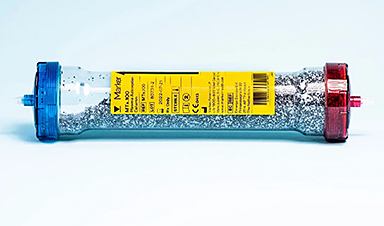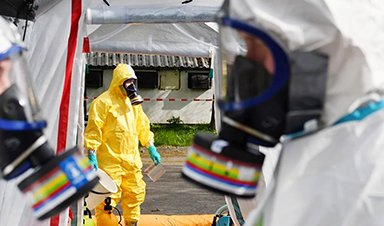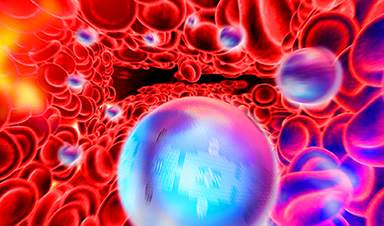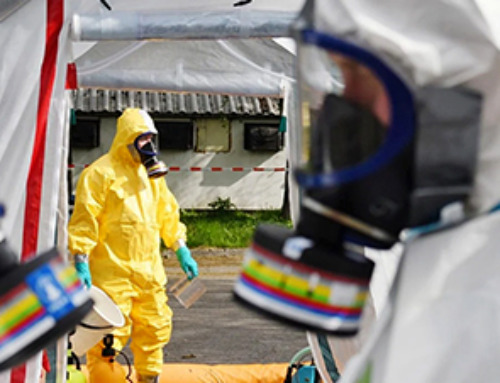This is a non-exhaustive list of places microplastics have been found: Mount Everest, the Mariana Trench, Antarctic snow, clouds, plankton, turtles, whales, cattle, birds, tap water, beer, salt, human placentas, semen, breast milk, feces, testicles, livers, brains, arteries, and blood.
My blood, specifically. In early March I milked a few drops out of my fingertips and sent the sample to be tested for microplastics. I was in the London office of Clarify Clinics—a firm that offers to cleanse your blood of microplastics, forever chemicals, and other toxins, in treatments that start at £9,750 ($12,636).
Each week around 10 to 15 people walk into the basement clinic just off Harley Street—a road famed for its private clinics and wealthy clientele. After a consultation, the patients settle down in an armchair for the treatment. Blood is drawn from a cannula into a machine that separates out the plasma from blood cells. That plasma is filtered through a column that is supposed to trap microplastics and other undesirable chemicals, before being mixed back with the blood cells and pumped back into the patient. All-in-all the process runs for up to two hours—enough time to process 50 to 80 percent of the blood plasma volume.
"Once it's running, you feel nothing. It's very comfortable," says Yael Cohen, CEO of Clarify Clinic. "Patients take calls, do Zooms, watch movies, sleep. The ones who sleep are my favorite." They come for all kinds of reasons, Cohen says: Some are suffering with chronic fatigue, others with brain fog or long Covid. The clinic also runs treatments marketed toward people on Ozempic-style weight-loss drugs, looking to conceive, or ward off dementia.
What Clarify sells them is the hope of easing their symptoms by ridding their blood of microplastics, or other potential contaminants such as PFAS chemicals (per- and polyfluoroalkyl substances) and pesticides. But the science on how microplastics affect our health is still far from conclusive. A 2022 WHO report into microplastics concluded that there wasn't yet enough evidence to figure out whether they posed a risk to human health. We don't know microplastics are safe, the report concluded, but we also don't know the risks they might pose.
But the 2024 study didn't establish any causal link between microplastics and health. The study was only observational, so it couldn't prove that the presence of microplastics caused the higher risk of death for certain patients. There were also differences between the two groups studied—patients with microplastics in their arteries were more likely to be men, have cardiovascular disease, and smoke. It could be that these factors—or another unknown influence—were actually causing the difference in risk of death between the two groups.
The same uncertainties apply when it comes to measuring microplastics. I wasn't particularly scientific when I milked that blood from my fingertip. Plastic fibers from my clothing or packaging could easily have made their way into my sample, and the same is true when any sample is analyzed, whether it's from the environment or a human body. Béen and his colleagues go to extreme lengths to try to avoid contamination when they're analyzing blood samples for microplastics. All of the equipment they use to take samples is plastic-free, the air in their lab is filtered, and they only wear cotton when working with the samples. "What we do is to make sure there is no plastic contamination, or to minimize it as much as possible given that microplastics are everywhere."
We live in such a plastic-saturated world that it's difficult to measure microplastics accurately, let alone link them to health outcomes. But Cohen says that her patients report higher energy levels or better sleep after trying the treatment. Cohen tracks her sleep quality on an Oura ring and says that before the treatment a score of 70 would be good for her, but in the six weeks after she tried the treatment she hadn't dropped below 90—which, according to the Oura website, indicates "optimal" sleep.
Most of the patients come to the clinic through word of mouth. "People are posting it, they're talking about it," Cohen says. Patients post their blood microplastic results online before and after the treatment. "I think it's a badge of honor to be doing your future self a favor," she says.
Blood microplastic cleansing is just the latest in a long line of treatments based on uncertain evidence targeting wealthy individuals worried about their health. In the Bahamas, people pay tens of thousands of dollars for stem cell injections of unproven benefit. Longevity influencer Bryan Johnson has touted the benefits of total plasma exchange—removing plasma from the blood and supplementing it with proteins and antibodies on a regular basis.
"He's a big platform, and he is spending a lot of time and energy finding the things that move the needle the most," says Cohen.
In extreme cases of exposure to pollutants, some form of blood cleaning can be necessary. Earlier this year, residents of Jersey, an island in the English Channel, were recommended bloodletting after firefighting foams containing PFAS polluted drinking water supplies. High levels of PFAS exposure have been linked to some cancers and issues with brain development and thyroid function. Bloodletting would clean the blood over time by removing contaminated blood and allowing the body to replenish the blood naturally.
But for most people we simply don't know what their blood microplastics levels are, or whether they are anything to worry about. My fingerprick test found around 190 microplastic particles per milliliter of blood, a result which apparently put me at the low end of the range of possible results. I emailed Cohen to tell her I was pleased with my results. "Glad you were pleasantly surprised, but that's still around a million particles in your circulatory system!" she responded.
News
Fever-Proof Bird Flu Variant Could Fuel the Next Pandemic
Bird flu viruses present a significant risk to humans because they can continue replicating at temperatures higher than a typical fever. Fever is one of the body’s main tools for slowing or stopping viral [...]
What could the future of nanoscience look like?
Society has a lot to thank for nanoscience. From improved health monitoring to reducing the size of electronics, scientists’ ability to delve deeper and better understand chemistry at the nanoscale has opened up numerous [...]
Scientists Melt Cancer’s Hidden “Power Hubs” and Stop Tumor Growth
Researchers discovered that in a rare kidney cancer, RNA builds droplet-like hubs that act as growth control centers inside tumor cells. By engineering a molecular switch to dissolve these hubs, they were able to halt cancer [...]
Platelet-inspired nanoparticles could improve treatment of inflammatory diseases
Scientists have developed platelet-inspired nanoparticles that deliver anti-inflammatory drugs directly to brain-computer interface implants, doubling their effectiveness. Scientists have found a way to improve the performance of brain-computer interface (BCI) electrodes by delivering anti-inflammatory drugs directly [...]
After 150 years, a new chapter in cancer therapy is finally beginning
For decades, researchers have been looking for ways to destroy cancer cells in a targeted manner without further weakening the body. But for many patients whose immune system is severely impaired by chemotherapy or radiation, [...]
Older chemical libraries show promise for fighting resistant strains of COVID-19 virus
SARS‑CoV‑2, the virus that causes COVID-19, continues to mutate, with some newer strains becoming less responsive to current antiviral treatments like Paxlovid. Now, University of California San Diego scientists and an international team of [...]
Lower doses of immunotherapy for skin cancer give better results, study suggests
According to a new study, lower doses of approved immunotherapy for malignant melanoma can give better results against tumors, while reducing side effects. This is reported by researchers at Karolinska Institutet in the Journal of the National [...]
Researchers highlight five pathways through which microplastics can harm the brain
Microplastics could be fueling neurodegenerative diseases like Alzheimer's and Parkinson's, with a new study highlighting five ways microplastics can trigger inflammation and damage in the brain. More than 57 million people live with dementia, [...]
Tiny Metal Nanodots Obliterate Cancer Cells While Largely Sparing Healthy Tissue
Scientists have developed tiny metal-oxide particles that push cancer cells past their stress limits while sparing healthy tissue. An international team led by RMIT University has developed tiny particles called nanodots, crafted from a metallic compound, [...]
Gold Nanoclusters Could Supercharge Quantum Computers
Researchers found that gold “super atoms” can behave like the atoms in top-tier quantum systems—only far easier to scale. These tiny clusters can be customized at the molecular level, offering a powerful, tunable foundation [...]
A single shot of HPV vaccine may be enough to fight cervical cancer, study finds
WASHINGTON -- A single HPV vaccination appears just as effective as two doses at preventing the viral infection that causes cervical cancer, researchers reported Wednesday. HPV, or human papillomavirus, is very common and spread [...]
New technique overcomes technological barrier in 3D brain imaging
Scientists at the Swiss Light Source SLS have succeeded in mapping a piece of brain tissue in 3D at unprecedented resolution using X-rays, non-destructively. The breakthrough overcomes a long-standing technological barrier that had limited [...]
Scientists Uncover Hidden Blood Pattern in Long COVID
Researchers found persistent microclot and NET structures in Long COVID blood that may explain long-lasting symptoms. Researchers examining Long COVID have identified a structural connection between circulating microclots and neutrophil extracellular traps (NETs). The [...]
This Cellular Trick Helps Cancer Spread, but Could Also Stop It
Groups of normal cbiells can sense far into their surroundings, helping explain cancer cell migration. Understanding this ability could lead to new ways to limit tumor spread. The tale of the princess and the [...]
New mRNA therapy targets drug-resistant pneumonia
Bacteria that multiply on surfaces are a major headache in health care when they gain a foothold on, for example, implants or in catheters. Researchers at Chalmers University of Technology in Sweden have found [...]
Current Heart Health Guidelines Are Failing To Catch a Deadly Genetic Killer
New research reveals that standard screening misses most people with a common inherited cholesterol disorder. A Mayo Clinic study reports that current genetic screening guidelines overlook most people who have familial hypercholesterolemia, an inherited disorder that [...]





















